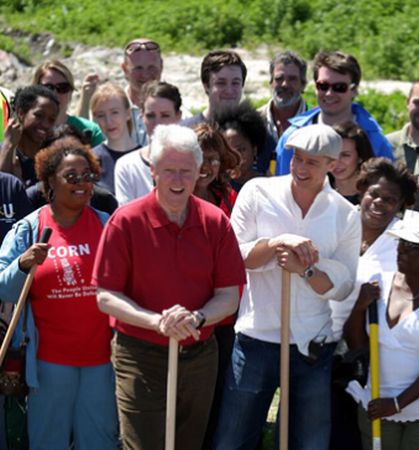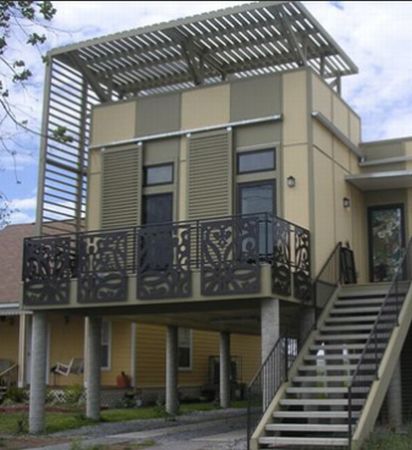It was a fateful day, forever etched into the memories of those who live on the American Gulf Coast, and beyond: August 29, 2005. This was the day Hurricane Katrina flooded 80 percent of the City of New Orleans, killing 1,577 people. Ground zero for Katrina, so to speak, was the historic Lower 9th Ward, where more than 4,000 homes were destroyed by a combination of surge-water (caused by the breach of the Industrial Canal levee) and the effects of the storm itself.
Two years later, you would expect that much of the area wiped out by the storm would be re-built and re-inhabited. But such was not the case when Brad Pitt–yes, the world-famous actor, of both cinematic and Brangelina fame–toured the City of Dreams. He found the Lower 9th Ward, a once-vibrant neighborhood, was still silent, desolate and destroyed.

Frustrated by what he saw as both a failure of government and a general lack of progress, Pitt met with local community groups and families to see what he could do–and shortly thereafter, established the Make It Right Foundation, a non-profit organization charged with a mission to build 150 green, affordable, high-quality homes in the neighborhood closest to the levee breach–a.k.a., the Lower 9th Ward.
The organization was first envisioned in December of 2006 and officially launched a year later, bringing national attention (and $12 in donations) to the need for re-building in New Orleans. Make It Right broke ground on its first project in March of 2008 and since that time, has completed over 70 new homes designed by 21 local, national and international architects, who donated their designs for single family homes and duplexes. (Make It Right’s architects were selected largely by Graftlab, an architecture firm and founding partner in the organization.)

Talk about a comeback: because all of the homes built by Make It Right to date have been certified as LEED Platinum for their energy efficiency and sustainability, the section of New Orleans’ Lower 9th Ward rebuilt by this organization is now “the largest, greenest neighborhood of single family homes in America,” according to the U.S. Green Building Council.
Those who benefit from the program are, of course, the area’s former residents. In order to qualify, applicants must have owned a home in the Lower 9th Ward prior to Hurricane Katrina. They are expected to contribute as much of their own financial resources as possible towards their new, green homes, with state programs like Road Home helping to close the gap to securing a loan for those in need. (Make It Right has full-time social workers and financial counselors on staff to support families through the process of qualifying for loans.) But if a former homeowner simply can’t swing the down-payment, Make It Right can subsidize housing as well.

Make It Right homeowner Ethel Fletcher of 1637 Tennessee Street was impressed by the organization’s professionalism. A Lower 9th Ward homeowner since 1957–when she moved to the area with her husband–Ms. Fletcher said, “Make It Right seemed legitimate compared to other programs. A lot of people would get your money and rip you off. With Make It Right, you feel like you’re dealing with friendly family people and that’s important when you’re spending a lot of money.”
Ms. Fletcher selected a three bedroom home designed by Billes Architecture. She says it was her number one choice because it was the best design. “It was up high so I could drive my car underneath it, and it has a front and back porch,” she said. “I’ve always wanted a back porch.” Ms. Fletcher is set to return to her old neighborhood in April of this year.

Green features of Make It Right homes include a 2.7 to 3.0 kilowatt-capacity solar photovoltaic systems; low-VOC paints, carpets, adhesives and finishes; and recycled materials wherever possible. They feature metal roofs to reduce heat gain and capture rainwater; native plants, rain gardens and green roofs; low flow plumbing and dual-flush toilets; cabinets made from wood that is certified by the Forest Stewardship Council; tankless water heaters; Energy Star Rated appliances and light fixtures; spray foam insulation; and low-e windows and doors.
These homes also take the potential for another Katrina seriously. Each is built 5 or 8 feet off the ground to ensure it stays beyond sustained flood levels, and features a roof hatch, which gives residents a safe way to a secure area on the roof. Other “hurricane-proof” elements include Hurricane Fabric (made of Kevlar) fitted to all windows; advanced framing techniques and specially-engineered wall sections, allowing homes to withstand winds of at least 130mph; an innovative drainage system that keeps water out of the wall system; fiber cement board siding designed to last 50 years against cracking, rotting, hail damage, termites and many other possible problems; Bluwood, an eco-friendly treated lumber product that resists moisture, mold, fungus, wood rot, and termites; and mold-resistent drywall.
What’s Make It Right going to do, once it achieves its mission of building 150 green homes in the Lower 9th Ward? Taylor Royle, Director of Communications for the organization told us, “Make It Right is frequently asked to serve as sustainability consultants on affordable housing for communities around the country. We are interested in helping in other communities, but our main focus for now is on completing our work in New Orleans.”
Information on Make It Right’s homes-in-progress is available online.